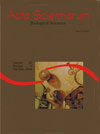<b>Local ecological knowledge of fishermen from Babitonga Bay, Santa Catarina, Brazil: fishes from the Serranidae family and marine environmental changes</b> - DOI: 10.4025/actascibiolsci.v28i3.226
Abstract
General aspects of the Local Ecological Knowledge (LEK) of long-line and spear fishermen on seven fish species of the Serranidae family (habitat use, maximum size and popular names) and on the main marine environmental changes were investigated in Babitonga Bay, Santa Catarina State, Brazil. In general, LEK on fishes corroborates the ichthyology literature, bringing original information in a local scale. Neighbor fishermen communities can develop different local species nomenclature and different LEK for fishery resources at the same area. We have verified that the fishing ban legislation on Epinephelus itajara in Brazil does not consider local species denominations, turning impossible its interpretation by local fishermen and generating conflicts on the law’s applicability. The main environmental changes registered were: decreasing abundance of fishery resources in general (and in particular that of the “Parambijú” (Cobia) Rachycentron canadum), and the effects of the anthropogenic interruption of the “Linguado Channel” on the hydrological and sedimentological characteristics of the Babitonga Bay (channel-bed shallowing and increased water turbidity).Downloads
Download data is not yet available.
Published
2007-11-14
How to Cite
Gerhardinger, L. C., Marenzi, R. C., Silva, M. H., & Medeiros, R. P. (2007). <b>Local ecological knowledge of fishermen from Babitonga Bay, Santa Catarina, Brazil: fishes from the Serranidae family and marine environmental changes</b> - DOI: 10.4025/actascibiolsci.v28i3.226. Acta Scientiarum. Biological Sciences, 28(3), 253-261. https://doi.org/10.4025/actascibiolsci.v28i3.226
Issue
Section
Ethnobiology
DECLARATION OF ORIGINALITY AND COPYRIGHTS
I Declare that current article is original and has not been submitted for publication, in part or in whole, to any other national or international journal.
The copyrights belong exclusively to the authors. Published content is licensed under Creative Commons Attribution 4.0 (CC BY 4.0) guidelines, which allows sharing (copy and distribution of the material in any medium or format) and adaptation (remix, transform, and build upon the material) for any purpose, even commercially, under the terms of attribution.
Read this link for further information on how to use CC BY 4.0 properly.
0.6
2019CiteScore
31st percentile
Powered by 

0.6
2019CiteScore
31st percentile
Powered by 











1.png)




3.png)













